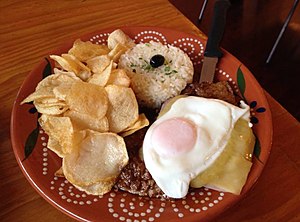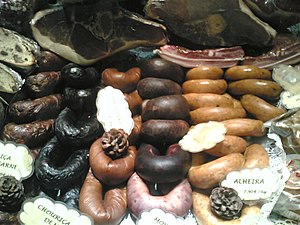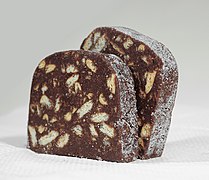Portuguese cuisine/ja: Difference between revisions
Created page with "''Porco bísaro''は、PDOの地位を持つ、ポルトガルの貴重な固有豚種である。この品種から派生したいくつかの製品、例えば「ブーショ・デ・ヴィニャイス」、「チョリソ・デ・オッソス・デ・ヴィニャイス」、「チョリサ・ドーチェ・デ・ヴィニャイス」もPGIの地位を有している。 ポルトガル王国の本土におけ..." |
Created page with "1878年、マセド・ピントはビサロ豚を「''Typo Bizaro''」または「''Celta''」に属する動物として記述し、上記の形態的特徴を持ち、体格、色、毛の多寡によって品種内の2つの変種を区別した。 thumb|right|伝統的なポルトガルのエンシーダス 彼は、枝肉200〜250kgの豚と120〜150kgの豚が存在すると考えた。色については、ほとんどが黒で、..." |
||
| Line 94: | Line 94: | ||
ポルトガル王国の本土における一般家畜調査(1870年)によると、「...ビサロとは、引き締まった、多かれ少なかれ脚の長い、耳の垂れた豚のことで、アレンテージョの良い太った有害な豚と区別される」。サンソンは「ケルト」という名称を提案し、この種類の品種の古さを表現するために使用している。この品種は、ポルトガル北部やガリシア、旧ガリア、イギリス諸島など、ケルト人が居住していた地域に唯一存在していた品種であり、アジア種やロマネスク種がこれらの国に導入される以前から存在していた。 | ポルトガル王国の本土における一般家畜調査(1870年)によると、「...ビサロとは、引き締まった、多かれ少なかれ脚の長い、耳の垂れた豚のことで、アレンテージョの良い太った有害な豚と区別される」。サンソンは「ケルト」という名称を提案し、この種類の品種の古さを表現するために使用している。この品種は、ポルトガル北部やガリシア、旧ガリア、イギリス諸島など、ケルト人が居住していた地域に唯一存在していた品種であり、アジア種やロマネスク種がこれらの国に導入される以前から存在していた。 | ||
1878年、マセド・ピントはビサロ豚を「''Typo Bizaro''」または「''Celta''」に属する動物として記述し、上記の形態的特徴を持ち、体格、色、毛の多寡によって品種内の2つの変種を区別した。 | |||
[[File:Enchidos portugueses.jpg|thumb|right|伝統的なポルトガルのエンシーダス]] | |||
[[File:Enchidos portugueses.jpg|thumb|right| | 彼は、枝肉200〜250kgの豚と120〜150kgの豚が存在すると考えた。色については、ほとんどが黒で、斑点のあるものもおり、白い毛のものはガリシア産であるため「ガレゴ」と呼ばれたという。モラリニョスは、毛が少なく滑らかでつるつるした皮膚を持つ斑点のある動物であった。 | ||
同著者によると、ビサロ豚は成長が遅く、肥育が難しい(2歳でようやく成長を完了する)、脂身よりも赤身肉を多く生産し、厚い[[bacon/ja|ベーコン]]の層よりも脂身を蓄積するとも述べている。 | |||
1946年、クーニャ・オルティゴーザは、ケルト族を起源とする「''Bísara''」品種を3つの国定品種の1つとして分類している。彼は、品種内の変種を記述する際、「''Galega''」と、「''Molarinho''」および「''Cerdões''」サブタイプを含む「''Beirôa''」に加えて分類している。 | |||
<div lang="en" dir="ltr" class="mw-content-ltr"> | <div lang="en" dir="ltr" class="mw-content-ltr"> | ||
Revision as of 17:39, 3 June 2025

| Culture of Portugal |
|---|
 |
| People |
| Cuisine |
| Festivals |
| Art |
ポルトガル料理(Portuguese: Cozinha portuguesa)は、ポルトガルにおける料理の伝統と慣習から成る。ポルトガル料理に関する現存する最古の書物である16世紀の『インファンタ・マリア・デ・ポルトガル料理書(Livro de Cozinha da Infanta D. Maria de Portugal)』には、肉、魚、鶏肉などの人気料理が多数記述されている。
「Olleboma」として知られるアントニオ=マリア・デ・オリベイラ・ベロによる『Culinária Portuguesa』は、1936年に出版された。 比較的大西洋、ケルト的な食料に限定されているにもかかわらず、ポルトガル料理にはフランス料理と地中海料理の強い影響も見られる。
ポルトガルの香辛料貿易が東インド、アフリカ、アメリカ大陸に与えた影響も顕著で、特に使用される香辛料の種類が豊富である。これらの香辛料には、「ピリピリ」(小さくて辛い唐辛子)、ホワイトペッパー、ブラックペッパー、サフラン、パプリカ、クローブ、オールスパイス、クミン、シナモン、ナツメグが含まれ、ポルトガル本土、アゾレス諸島、マデイラ諸島の肉料理、魚料理、または複数の風味豊かな料理に使用される。 シナモン、バニラ、レモンゼスト、オレンジゼスト、アニスシード、クローブ、オールスパイスは、多くの伝統的なデザートや一部の風味豊かな料理に使用される。
ニンニクとタマネギは広く使われており、ハーブも同様です。ローリエ、パセリ、オレガノ、タイム、ミント、マジョラム、ローズマリー、そしてコリアンダーが最も一般的です。

オリーブオイルはポルトガル料理の基本の一つで、調理にも料理の風味付けにも使われます。このため、ポルトガルでは酸度によってオリーブオイルが独自に分類されています。酸度1.5度のものは調理専用(バージンオリーブオイル)で、1度以下のものは魚、ジャガイモ、野菜にかけるのに適しています(エキストラバージン)。酸度0.7度、0.5度、さらには0.3度のものは、オリーブオイルの味が全く好きではない方や、マヨネーズやソースのように味が隠れるような用途で使いたい方のためにあります。
ポルトガル料理は大西洋式食事法に基づいており、肉類(豚肉、牛肉、鶏肉が主で、ジビエなど)、魚介類(魚、ロブスター、カニ、エビ、クルマエビ、タコなどの甲殻類、ホタテ、アサリ、フジツボなどの軟体動物)、多種多様な野菜類(アブラナ科)、豆類、そしてデザート(ケーキが最も多い)が含まれます。 ポルトガル人はしばしば食事とともに米、ジャガイモ、菜の花(「grelos」として知られています)、パンを摂取し、ポルトガル語圏やガリシア語の影響下にある国々には、伝統的な焼きたてパン、例えば「broa」のようなものが多数あり、地域や国によってバリエーションがあります。 広義には、ポルトガル料理とガリシア料理は多くの伝統と特徴を共有しています。
中世
中世、ポルトガル人は主に牧畜で生計を立てていた。彼らは穀物、野菜、根菜、豆類、栗、家禽、牛、豚などを栽培し、食料としていました。ほとんどの地域で漁業や狩猟も一般的でした。この時期には、ブドウの木やオリーブの木といった植物とともに、魚を保存するための新しい方法が導入されました。パン(ライ麦、小麦、大麦、オート麦)は広く消費され、ほとんどの人々の主食でした。 甘いオレンジは15世紀にポルトガルの商人によってポルトガルに持ち込まれました。今日の多くの食品、例えばジャガイモ、トマト、チリ、ピーマン、トウモロコシ、カカオ、バニラ、七面鳥などは、1492年のコロンブスによるアメリカ大陸到達まではヨーロッパでは知られていませんでした。
食事

ポルトガルの朝食は、多くの場合、バター、ハム、チーズ、またはジャムを添えた焼きたてのパンと、コーヒー、牛乳、紅茶、あるいはホットチョコレートから成る。エスプレッソコーヒー(コーヒーマシンの注ぎ口にちなんで「ビーカ」、またはイタリアのコーヒーマシン「ラ・チンバリ」にちなんで「シンバリーノ」と呼ばれることもある)は、朝食時や昼食後によく飲まれる人気の飲み物で、自宅やポルトガルの街中の多くのカフェで楽しまれている。 甘いペイストリーも非常に人気があり、朝食用のシリアルも牛乳やヨーグルト、フルーツと混ぜて食べられる。ポルトガル料理の最も際立ったシンボルの一つであるパステル・デ・ナタは、ポルトガルの朝食によく登場する。朝食時にも午後の軽食としても、エスプレッソとともに頻繁に楽しまれている。
昼食は、しばしば1時間以上かけて、正午から2時の間、通常は1時頃に提供され、夕食は一般的に8時頃に提供されます。主なコースは3つあり、昼食と夕食には通常スープが含まれます。ポルトガルの一般的なスープは「カルド・ヴェルデ」で、これは調理してピュレ状にしたジャガイモ、タマネギ、ニンニクをベースに、細かく刻んだコラードグリーンを加えたものです。スライスした「チョリソ」(燻製またはスパイシーなポルトガルソーセージ)が加えられることも多いですが、省略することも可能で、その場合は完全にヴィーガン対応のスープになります。
魚料理の中でも、塩漬けのタラ(バカリャウ)を使った料理が非常に普及している。最も人気のあるデザートは、「プディング・デ・オーヴォス」または「フラン・デ・カラメロ」として知られるカスタードプディング、「ムース・デ・ショコラ」として知られるチョコレートムース、「レイテ・クレーム」として知られるクレームブリュレ、シナモンで飾られた「アロス・ドーセ」として知られるライスプディング、そして「タルテ・デ・マサン」として知られるアップルタルトである。 また、羊、山羊、または牛乳から作られる多種多様なチーズもある。これらのチーズは、異なる種類のミルクの混合物を含むこともある。最も有名なのは、セーラ・ダ・エストレーラ地方の「ケイジョ・ダ・セーラ」、サン・ジョルジェ島の「ケイジョ・サン・ジョルジェ」、そして「レケイジョン」である。人気のペイストリーは「パステル・デ・ナタ」で、シナモンがよく振りかけられた小さなカスタードタルトである。
魚介類


ポルトガルは海に面した国であり、漁業が発達しており、これは食される魚介類の量に反映されている。同国の一人当たりの魚介類消費量はヨーロッパで最も高く、この指標では世界トップ4に入る。魚は、グリル、茹でる(ポシェや煮るも含む)、揚げる(素揚げも含む)、caldeiradaとして知られる煮込み料理(しばしば土鍋調理)、ロースト、あるいは蒸し物として供される。
中でも特筆すべきは、ポルトガルで最も消費される魚であるbacalhau(タラ)である。タラの調理法は365種類以上あると言われており、これは一年の毎日につき少なくとも一品があることを意味する。タラは、冷蔵技術の発明以前に北大西洋でのポルトガルの漁業が発展したため、ほとんど常に乾燥させ塩漬けされたものが用いられ、調理前に水または牛乳に浸す必要がある。シンプルな魚料理には、しばしばエクストラバージンオリーブオイルと白ワインビネガーで風味付けされる。
ポルトガルでは15世紀からタラの漁業と貿易が行われており、このタラの貿易がタラの料理における普及の理由となっている。その他の人気の魚介類には、新鮮なイワシ(特にsardinhas assadasとして)、シーバス、フエダイ、メカジキ、サバ、舌平目、ブリル、オヒョウ、マトウダイ、ターボット、アンコウ、タコ、イカ、コウイカ、カニ、エビ、ロブスター、イセエビ、そしてフジツボ、メルルーサ、マアジ(アジ類)、タチウオ(特にマデイラ諸島)、その他様々な魚や貝類、そしてアサリ、ムール貝、カキ、ホタテガイ、イシダタミガイなどの軟体動物といった、多くの甲殻類が含まれる。
カルディラーダは、様々な魚(ターボット、アンコウ、メルルーサ、ムール貝)や貝類からなる様々なシチューで、プロヴァンス地方のブイヤベースに似ている。また、肉やジビエと複数の野菜材料からなるものもある。これらのシチューは伝統的に、(ラピーニ) グレロス、ジャガイモ、トマト、ペリペリ、ピーマン、パセリ、ニンニク、タマネギ、ペニーロイヤル、そして一部の地域ではコリアンダーなどから構成される。
川のヤツメウナギやウナギは、淡水の珍味とされている。ポルトガル中央部のコインブラ地方やアヴェイロ地方は、ウナギのシチューやヤツメウナギの季節料理、祭りで有名である。アルガニルやペナコヴァでは、Arroz de LampreiaやLampreia à Bordalesaといった人気料理がある。

イワシはかつて、地方での販売のために塩水漬けにされて保存されていた。その後、ポルトガル沿岸各地でイワシの缶詰工場が発展した。エイはポルトガル北部で天日干しにされる。缶詰のマグロはポルトガル本土で広く流通している。マグロはかつてアルガルヴェ地方の海域で豊富に獲れた。マグロは地中海での産卵に向かう際にポルトガル南岸を通過する際、そして大西洋に戻る際に定置網で捕獲された。ポルトガルの作家ラウル・ブランダンは、著書『Os Pescadores』の中で、マグロがどのようにして引き上げられた網から船に釣り上げられたか、そして漁師たちが大きな魚に乗って網の周りを回って楽しんだ様子を描写している。しかし、新鮮なマグロは通常、マグロのステーキが郷土料理の重要な品目であるマデイラ諸島とアルガルヴェ地方で食される。缶詰のイワシやマグロは、茹でたジャガイモ、黒目豆、コラードグリーン、固ゆで卵と共に供され、手の込んだ料理を作る時間がない場合に手軽な食事となる。
肉と家禽

肉や家禽肉を日常的に食べることは、歴史的に上流階級の特権であった。豚肉と牛肉は、この国で最も一般的な肉である。肉は中世の貴族の食卓の主食であった。ポルトガルのルネサンス期の年代記作家、ガルシア・デ・レゼンデは、王室の晩餐会での主菜が、鶏肉で飾り付けられた丸ごと一頭のロースト雄牛であったと記述している。主に冬に食べられる一般的なポルトガル料理はcozido à portuguesaで、これはフランスのpot-au-feuやニューイングランド風煮込み料理にいくぶん似ている。その構成は料理人の想像力と予算に依存する。贅沢なコジードには、牛肉、豚肉、塩漬け豚肉、数種類のシャルキュトリー(塩漬けのチョリソ、モルセーラ・エ・チョリソ・デ・サングレ、リングイサ、ファリニェイラなど)、豚足、生ハム、ジャガイモ、ニンジン、カブ、キャベツ、米が含まれることがある。これは元々、裕福な農民のお気に入りの食べ物であり、後に都市のブルジョワジーや典型的なレストランの食卓に上るようになった。
肉



Tripas à moda do Porto (トリッパと白インゲン豆の煮込み)は、14世紀にカスティーリャ軍がリスボンを包囲し、テージョ川の入り口を封鎖した際に生まれたと言われている。ポルトガルの年代記作家フェルナン・ロペスは、飢餓が街中に広がり、食料価格が天文学的に高騰した様子を劇的に描写している。小さな少年たちはかつての小麦市場で地面に落ちた数粒の穀物を探し、見つけると熱心に口に入れたという。老人や病人、娼婦、要するに街の防衛に協力できない者は皆、カスティーリャ軍の陣営に送られたが、侵略者によってリスボンに送り返された。この時、ポルト市民は川の封鎖をかいくぐって補給艦隊を組織することを決意した。どうやら、一時的に利用できるすべての肉が首都に送られたため、ポルトの住民はトリッパや他の臓器に限定されたようだ。別の説では、ポルトが肉を自ら断ち、セウタ市を征服するための遠征に供給したのは1415年のことであったと主張している。真実が何であれ、少なくとも17世紀以来、ポルトの人々はトリペイロス、つまりトリッパ食いとして知られている。トリッパを使ったもう一つのポルトガル料理はドブラダである。
現在、ポルト地方は「フレンチー」を意味するfrancesinhaとして知られるトーストサンドイッチでも同様に有名である。
ポルトガル料理には他にも多くの肉料理がある。バイラーダ地方では、Leitão à Bairrada (子豚の丸焼き)という有名な料理がある。その近くでは、chanfana(ヤギ肉を赤ワイン、パプリカ、白胡椒でじっくり煮込んだもの)という別の料理が、ミランダ・ド・コルヴォ(「チャンファーナの首都」)とヴィラ・ノヴァ・デ・ポイアレス(「チャンファーナの世界首都」)の2つの町に由来を主張されている。 Carne de porco à alentejanaは、豚肉とアサリの炒め物で人気のある料理だが、その名前と起源については諸説ある。アサリは、アレンテージョ地方ではあまり一般的ではないだろう。この地方には、シネスという一つの大きな漁港と小さな漁村しかないからである。むしろ、アルガルヴェ地方とその海辺の町でははるかに広く使われているだろう。この料理がアルガルヴェ地方に属するという説の一つは、この地方の豚がかつて魚の副産物を餌としていたため、肉の生臭さを隠すためにアサリが豚肉の炒め物に加えられたというものである。この料理は中世において、改宗ユダヤ人の新しいキリスト教信仰を試すために用いられた。豚肉と魚介類(コーシャーではない二つの食材)からなるこの料理を、クリスタオス・ノーヴォスは、ユダヤ教を放棄したことを証明するために公衆の面前で食べることが求められた。アルト・アレンテージョ(北アレンテージョ)には、豚肉または子羊肉の肺、血、肝臓を使った料理がある。この伝統的なイースター料理は、一年を通して他の時期にも食べられる。地域に伝わる島の料理、アルカトラは、牛肉を赤ワイン、ニンニク、クローブやオールスパイスなどの香辛料でマリネし、土鍋で焼いたもので、アゾレス諸島のテルセイラ島の伝統である。
ポルトガル風ステーキのbifeは、スパイスに漬け込んだ牛肉または豚肉のソテーで、ワインベースのソースとフライドポテト、ライス、またはサラダが添えられる。肉の上に目玉焼きを乗せることもあり、その場合、料理はbife com ovo a cavalo(馬に乗った卵つきステーキ)という新しい名前になる。この料理は、肉がグリルに2回しか「触れない」ことを意味するbitoqueと呼ばれることもある。これは、肉が提供される前にあまり長くグリルされず、レアからミディアムレアの焼き加減になることを意味する。bifeのもう一つのバリエーションはbife à casa(ハウスステーキ)で、これはbife a cavaloに似ていることもあれば、アスパラガスなどの付け合わせが特徴であることもある。
Iscas(レバーのソテー)は、昔のリスボンの居酒屋で人気の注文だった。時にはiscas com elasと呼ばれ、elasはソテーしたジャガイモを指した。ロールパンに入った小さな牛肉や豚肉のステーキ(それぞれpregosやbifanas)は人気の軽食で、しばしばビアホールで大きなビールジョッキと共に供される。現代では、スナックバーのカウンターで食べるpregoやbifanaが、それ自体でランチになることもある。 Espetada(串焼き肉)は、マデイラ島で非常に人気がある。
シャルキュトリー

トラズ・オス・モンテス地方の黄色いソーセージアルヘイラは、伝統的にフライドポテトと目玉焼きと共に供され、興味深い歴史を持つ。15世紀後半、ポルトガル王マヌエル1世は、居住するすべてのユダヤ人にキリスト教への改宗か国外退去を命じた。 王は、王国の経済的・専門的エリートを構成していたユダヤ人を追放することを本心では望んでいなかったが、外部からの圧力によりそうせざるを得なかった。そのため、期限が到来すると、改宗を拒否した大多数の人々には船が利用できないと発表し、男性、女性、子供たちを強制的に教会に連行し、強制的な集団洗礼を行わせた。船の近くで洗礼を受けた者もおり、これは当時人気を博した概念「baptizados em pé」、文字通り「立ちながら洗礼を受けた」を生み出した。一部のユダヤ人は密かに信仰を守りながらも、善良なキリスト教徒のイメージを示そうとしたと考えられている。豚肉を避けることはポルトガル異端審問の目には明らかな慣行であったため、新キリスト教徒たちは、豚肉でできているように見せかけるが、実際には香辛料を大量に効かせたジビエと鶏肉のみを含むソーセージを考案した。時が経つにつれて、豚肉がアルヘイラに加えられるようになった。 PGI保護認定されたアルヘイラの品種には、Alheira de ヴィニャイスとAlheira de Barroso-Montalegre Municipalityがある。
ChouriçoまたはChouriça(後者は通常、より大きく厚いものを指す)は独特のソーセージであり、チョリソーと混同してはならない。これは(少なくとも)豚肉、脂身、パプリカ、ニンニク、塩(ワインや時にコショウも一部の地域では一般的な材料である)で作られる。その後、豚や子羊の天然ケーシングに詰められ、ゆっくりと煙で乾燥される。多種多様な品種があり、色、形、スパイス、味が異なる。白胡椒、ピリピリ、クミン、シナモンは、ポルトガルの旧植民地や島々でしばしば追加される。伝統的なポルトガルの硬化チョリソの種類はより肉厚で、しばしば赤ワインが使われ、スパイスはあまり多くない。多くのポルトガル料理では、cozido à portuguesaやfeijoadaなど、chouriçoが使用される。
ファリニェイラは、小麦粉を主原料とするもう一つのポルトガル燻製ソーセージである。このソーセージは、コジード・ア・ポルトゥゲーザなどの伝統料理の材料の一つである。ボルバ、エストレモス、ポルタレグレのファリニェイラはすべて、欧州連合において「PGI」(保護地理的表示)を受けている。

プレスント(プロシュートハム)は、ポルトガルで非常に多くの種類があり、最も有名なものはシャベス地方のものである。プレスントは通常、薄切りまたは小さく切って、食前酒や紅茶と共に、あるいは様々な料理の材料として消費される。
プレズントには、PDO(原産地名称保護)またはPGI(地理的表示保護)によって欧州法で保護されているいくつかの種類があり、例えばバランコス産プレズントやヴィニャイス産ビサロプレズントなどがある。
Porco bísaroは、PDOの地位を持つ、ポルトガルの貴重な固有豚種である。この品種から派生したいくつかの製品、例えば「ブーショ・デ・ヴィニャイス」、「チョリソ・デ・オッソス・デ・ヴィニャイス」、「チョリサ・ドーチェ・デ・ヴィニャイス」もPGIの地位を有している。 ポルトガル王国の本土における一般家畜調査(1870年)によると、「...ビサロとは、引き締まった、多かれ少なかれ脚の長い、耳の垂れた豚のことで、アレンテージョの良い太った有害な豚と区別される」。サンソンは「ケルト」という名称を提案し、この種類の品種の古さを表現するために使用している。この品種は、ポルトガル北部やガリシア、旧ガリア、イギリス諸島など、ケルト人が居住していた地域に唯一存在していた品種であり、アジア種やロマネスク種がこれらの国に導入される以前から存在していた。
1878年、マセド・ピントはビサロ豚を「Typo Bizaro」または「Celta」に属する動物として記述し、上記の形態的特徴を持ち、体格、色、毛の多寡によって品種内の2つの変種を区別した。

彼は、枝肉200〜250kgの豚と120〜150kgの豚が存在すると考えた。色については、ほとんどが黒で、斑点のあるものもおり、白い毛のものはガリシア産であるため「ガレゴ」と呼ばれたという。モラリニョスは、毛が少なく滑らかでつるつるした皮膚を持つ斑点のある動物であった。 同著者によると、ビサロ豚は成長が遅く、肥育が難しい(2歳でようやく成長を完了する)、脂身よりも赤身肉を多く生産し、厚いベーコンの層よりも脂身を蓄積するとも述べている。 1946年、クーニャ・オルティゴーザは、ケルト族を起源とする「Bísara」品種を3つの国定品種の1つとして分類している。彼は、品種内の変種を記述する際、「Galega」と、「Molarinho」および「Cerdões」サブタイプを含む「Beirôa」に加えて分類している。
Portuguese cold cuts and sausages (charcutaria and enchidos, respectively) have long and varied traditions in meat preparation, seasoning, preservation and consumption: cured, salted, smoked, cooked, simmered, fermented, fried, wrapped, dried. Regional variations in form and flavour, specialities and names also occur. Further pork (and other meats) charcuterie products include toucinho, paio, morcela, beloura, bucho, butelo, cacholeira, maranho, pernil, salpicão and others.
Poultry

Chicken, duck, turkey, red-legged partridge and quail are all elements of Portuguese cuisine. Dishes include frango no churrasco (chicken on churrasco), chicken piri-piri, cabidela rice, canja de galinha, and arroz de pato (duck rice), among others.
Turkeys were only eaten for Christmas or on special occasions, such as wedding receptions or banquets. Until the 1930s, farmers from the outskirts of Lisbon would come around Christmastime to bring herds of turkeys to the city streets for sale. Nowadays, mass production in poultry farms makes these meats accessible to all classes. Bifes de peru, turkey steaks, have thus become an addition to Portuguese tables.
Vegetables and starches

Vegetables that are popular in Portuguese cookery include numerous cabbage and collard varieties, sprouts(traditionally collected from turnips and different cabbage shoots) tomatoes, onions and peas. There are many starchy dishes, such as feijoada, a rich black bean stew with beef and pork, and açorda, a Portuguese bread soup. Numerous ’’cozido’’ stews are prepared from kale, white beans, red beans, Catarino and Bragançano, fava beans, black eyed beans. Several pumpkins like menina and porqueira varietals, are used in soups and soufflés. One of numerous vegetable and starch rich soups and broths is caurdo or caldo à Lavrador, a soup made of cabbage, red beans, potatoes, prosciutto chunks and wheat flour.
Many dishes are served with salads often made from tomato, lettuce, shredded carrots and onion, usually seasoned with olive oil and vinegar. Potatoes and rice are also extremely common in Portuguese cuisine. Soups made from a variety of vegetables, root vegetables, meats and beans are commonly available, one of the most popular being caldo verde, made from thinly sliced kale, potato purée, and slices of chouriço.
Fruits, nuts, and berries

Before the arrival of potatoes from the New World, chestnuts (Castanea sativa) were widely used as seasonal staple ingredients. There is a revival of chestnut dishes, desserts and compotes in Portugal and production is relevant in inland areas of central and northern Portugal.
Other seasonal fruits, nuts and berries such as pears, apples, table grapes, plums, peaches, cherries, sour cherries, melons, watermelons, citrus, figs, pomegranates, apricots, walnuts, pine nuts, almonds, hazelnuts, strawberries, raspberries, blackberries, redcurrant and blueberries are part of the Portuguese diet. These are consumed naturally or used as desserts, marmalades, compotes, jellies and liqueurs.
Cheese

There are a wide variety of Portuguese cheeses, made from cow's, goat's or sheep's milk. Usually these are very strongly flavoured and fragrant. Traditional Portuguese cuisine does not include cheese in its recipes, so it is usually eaten on its own before or after the main dishes. The Queijo da Serra da Estrela, which is very strong in flavour, can be eaten soft or more matured. Serra da Estrela is handmade from fresh sheep's milk and thistle-derived rennet. In the Azores islands, there is a type of cheese made from cow's milk with a spicy taste, the Queijo São Jorge. Other well known cheeses with protected designation of origin, such as Queijo de Azeitão, Queijo de Castelo Branco. Queijo mestiço de Tolosa , is the only Portuguese cheese with protected geographical indication and is made in the civil parish of Tolosa, part of the municipality of Nisa, which itself has another local variation within the Portalegre District, Queijo de Nisa.
Coffee
Alcoholic beverages
Wine (red, white and "green") is the traditional Portuguese drink, the rosé variety being popular in non-Portuguese markets and not particularly common in Portugal itself. Vinho verde, termed "green" wine, is a specific kind of wine which can be red, white or rosé, and is only produced in the northwestern (Minho province) and does not refer to the colour of the drink, but to the fact that this wine needs to be drunk "young". A "green wine" should be consumed as a new wine while a "maduro" wine usually can be consumed after a period of ageing. Green wines are usually slightly sparkling.
Traditionally grown on the schist slopes of the River Douro and immediate tributaries, Port wine is a fortified wine of distinct flavour produced in Douro, which is normally served with desserts.
Alvarinho white wines from Minho are also highly sought after.
Vinho da Madeira, is a regional wine produced in Madeira, similar to sherry. From the distillation of grape wastes from wine production, this is then turned into a variety of brandies (called aguardente, literally "burning water"), which are very strong-tasting. Typical liqueurs, such as Licor Beirão and Ginjinha, are very popular alcoholic beverages in Portugal. In the south, particularly the Algarve, a distilled spirit called medronho, which is made from the fruit of the strawberry tree.
Beer was already consumed in Pre-Roman times, namely by the Lusitanians who drank beer much more than wine. The Latinised word ‘cerveja’ (from cerevisia < cervesia) derives from an older Celtic term used in Gaul. During the Reconquista, many knights from Northern Europe preferred beer to the local wine. The ‘Biergarten’ culture, called Cervejaria in Portugal, is widespread in all regions and several local brands are popular with locals and visitors alike. Lisbon has a Beer Museum focusing on Portuguese and Lusophone countries' beer traditions.
Pastries and sweets


Portuguese sweets have had a large impact on the development of Western cuisines. Many words like marmalade, caramel, molasses and sugar have Portuguese origins.
The Portuguese sponge cake called pão de ló is believed to be based on the 17th century French recipe pain de lof, which in turn derived from Dutch "loef". The French eventually called their cake Genoise.
Probably the most famous of the Portuguese patisseries are the pastéis de nata, originally known as Pastéis de Belém in the Lisbon district with the same name in the early nineteenth century. It is unclear when and where the recipe was first started. Monks of the military-religious Order of Christ lived in a church on the same location and provided assistance to seafarers in transit since the early fourteenth century, at least.
The House of Aviz and the Jerónimos Monastery followed, the monastery lastly being occupied by the Hieronymite monks. Following the 1820 liberal revolution, events led to the closure of all monastic orders. The Pastéis de Belém were first commercialised just outside the Jerónimos monastery by people who had lost their jobs there. The original patisserie, adjacent to the monastery still operates today. This pastry is now found worldwide, it is known in the UK by its original name or also as Portuguese custard tart. In 2011, the Portuguese public voted on a list of over 70 national dishes. Eventually naming the pastel de nata one of the seven wonders of Portuguese gastronomy.
Many of the country's typical pastries were created in the Middle Ages monasteries by nuns and monks and sold as a means of supplementing their incomes. The names of these desserts are usually related to monastic life; barriga de freira (nun's belly), papos d’anjo (angel's double chin), and toucinho do céu (bacon from heaven). For that reason, they are often referred to as doçaria conventual or receitas monásticas (monastic recipes). Their legacy dates back to the 15th century when sugar from overseas became easier to access by all classes. Nuns at the time, were often young nobles who inherited knowledge from their households and developed recipes. These recipes were passed and perfected from generation to generation, usually within the secrecy of convents. Many of today's Portuguese desserts originated in convents and monasteries.
The Andalusian influence in Southern Portugal can be found in sweets that incorporate figs, almonds and honey, namely the Algarve marzipan colourful sweets, or the almond tuiles, known as telhas d’amêndoa.
Most towns have a local specialty, usually egg or cream-based pastry. Some examples are leite-creme (a dessert consisting of an egg custard-base topped with a layer of hard caramel, a variant of creme brûlée) and pudim flã.
Other very popular pastries found in most cafés, bakeries and pastry shops across the country are the Bola de Berlim, the Bolo de arroz, and the Tentúgal pastries.
Doce de gila (made from chilacayote squash), wafer paper, and candied egg threads called fios de ovos or angel hair.
-
Pão-de-Ló
-
Rabanadas and filhós, typical Christmas dessert
-
Leite-creme (Portuguese Crème brûlée)
-
Arroz Doce (Rice pudding)
-
Bola de Berlim (a type of Berliner)
-
Salame de Chocolate (Chocolate salami)
Influences on world cuisine


Portugal formerly had a large empire and the cuisine has been influenced in both directions. Other Portuguese influences reside in the Chinese territory of Macau (Macanese cuisine) and territories who were part of the Portuguese India, such as Goa or Kerala, where vindalho (a spicy curry), shows the pairing of vinegar, chilli pepper and garlic.
The Persian orange, grown widely in southern Europe since the 11th century, was bitter. Sweet oranges were brought from India to Europe in the 15th century by Portuguese traders. Some Southeast Indo-European languages name the orange after Portugal, which was formerly its main source of imports.
Examples are Albanian portokall, Bulgarian portokal [портокал], Greek portokali [πορτοκάλι], Persian porteghal [پرتقال], and Romanian portocală. In South Italian dialects (Neapolitan), the orange is named portogallo or purtualle, literally "the Portuguese ones". Related names can also be found in other languages: Turkish Portakal, Arabic al-burtuqal [البرتقال], Amharic birtukan'’ [ብርቱካን], and Georgian phortokhali [ფორთოხალი].
The Portuguese imported spices, such as cinnamon (Cinnamomum verum) now liberally used in its traditional desserts and savoury dishes, from Asia.
The Portuguese "canja", chicken soup made with pasta or rice, is a popular food therapy for the sick, which shares similarities with the Asian congee, used in the same way, indicating it may have come from the East.
In 1543, Portuguese trade ships reached Japan and introduced refined sugar, valued there as a luxury good. Japanese lords enjoyed Portuguese confectionery so much it was remodelled in the now traditional Japanese konpeitō (candy), kasutera (sponge cake), and keiran somen (the Japanese version of Portuguese "fios de ovos", also popular in Thai cuisine under the name of "kanom foy tong"), creating the Nanban-gashi, or "New-Style Wagashi". During this Nanban trade period, tempura (resembling Portuguese peixinhos da horta) was introduced to Japan by early Portuguese missionaries.

Tea was made fashionable in England in the 1660s after the marriage of King Charles II to the Portuguese princess Catherine of Braganza (Catarina De Bragança), who brought her liking for tea, originally from the colony of Macau, to the court. When Catherine relocated up north to join King Charles, she is said to have packed loose-leaf tea as part of her personal belongings; it would also have likely been part of her dowry. Queen Catherine also introduced marmalade to the English and made the habit of eating with a fork a part of the court's table etiquette.
All over the world, Portuguese immigrants influenced the cuisine of their new "homelands", such as Hawaii and parts of New England. Pão doce (Portuguese sweet bread), malassadas, sopa de feijão (bean soup), and Portuguese sausages (such as linguiça and chouriço) are eaten regularly in the Hawaiian islands by families of all ethnicities. Similarly, the "papo-seco" is a Portuguese bread roll with an open texture, which has become a staple of cafés in Jersey, where there is a substantial Portuguese community.
In Australia and Canada, variants of "Portuguese-style" chicken, sold principally in fast food outlets, have become extremely popular in the last two decades. Offerings include conventional chicken dishes and a variety of chicken and beef burgers. In some cases, such as "Portuguese chicken sandwiches", the dishes offered bear only a loose connection to Portuguese cuisine, usually only the use of "piri-piri sauce" (a Portuguese sauce made with piri piri).
The Portuguese had a major influence on African cuisine and vice versa. They are responsible for introducing corn in the African continent. In turn, the South African restaurant chain Nando's, among others, have helped diffusing Portuguese cuisine worldwide, in Asia for example, where the East Timorese cuisine also received influence.
マデイラワインと初期アメリカの歴史

In the 18th century Madeira wine became extremely popular in British America. Barrel-aged Madeira especially was a luxury product consumed by wealthy European colonists. The price continued to rise from £5 at the start of the 18th century to £43 by the early 19th century. It was even served as a toast during the First Continental Congress in 1775.
Madeira was an important wine in the history of the United States of America. No wine-quality grapes could be grown among the 13 colonies, so imports were needed, with a great focus on Madeira. One of the major events on the road to revolution in which Madeira played a key role was the seizure of John Hancock's sloop the Liberty on 9 May 1768 by British customs officials. Hancock's boat was seized after he had unloaded a cargo of 25 casks (3,150 gallons) of Madeira wine, and a dispute arose over import duties. The seizure of the Liberty caused riots to erupt among the people of Boston.
Madeira wine was a favorite of Thomas Jefferson after George Wythe introduced him to it. It was used to toast The Declaration of Independence and George Washington, Betsy Ross, Alexander Hamilton, Benjamin Franklin, and John Adams are also said to have appreciated the qualities of Madeira. The wine was mentioned in Benjamin Franklin's autobiography. On one occasion, Adams wrote to his wife, Abigail, of the great quantities of Madeira he consumed while a Massachusetts delegate to the Continental Congress. A bottle of Madeira was used by visiting Captain James Server to christen the USS Constitution in 1797. Chief Justice John Marshall was also known to appreciate Madeira, as did his fellow justices on the early U.S. Supreme Court.
関連項目
外部リンク
| この記事は、クリエイティブ・コモンズ・表示・継承ライセンス3.0のもとで公表されたウィキペディアの項目Portuguese cuisine(29 May 2025, at 00:05編集記事参照)を翻訳して二次利用しています。 |







